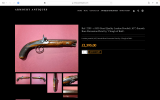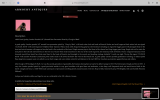WOW!...NICE!...to bad not in much better shape, even worse the NMLRA Spring National Shooting Championships was last week. A lot of information could have been found and shared. However, the Fall Championship Matches are not far away September 10-18, 2022. Both events are held at the NMLRA headquarters in Friendship, Indiana. These events bring together some-a lot- of the most knowledgeable people in muzzleloading.
I am recommending you contact the Bevel Brothers via the National Muzzle Loading Rifle Association and sending all of these photos and information you can on this firearm to them for their opinion and further information.
I stand corrected as the nipple does appear it might have been made for musket caps.
The channel and hole in the stock is where the ramrod would be placed. The hole between the ramrod channel and barrel bed is for mounting a ramrod thimble. It could be this odd piece at the muzzle would be held in place under the barrel by the ramrod. This also leads me to believe the barrel may have been longer at one time.
Withe better photos (IMO) still leads me to believe the odd piece at the muzzle is used for accurate alignment of the ball suggesting once again a target or dueling pistol or maybe both.
The lock:
Using a spring vise and being extremely careful, because the spring maybe brittle, with ease collapse the spring, Cocking the hammer periodically, till the hammer catch fits into the hook of the spring. The hammer is now functional.
Curious:
Can you post some pics of the trigger in the stock and separate from the stock?
The picture of the grip cap in your OP looks to have a piece of metal attached by a screw, while in other pics this piece in not shown.
By enlarging the photos and not seeing this piece in other photos, I can only speculate the metal piece having a "U" shape is a concealed decapper. Which would further indicate the pistol is more likely a target pistol.
The muzzle and barrel length puzzle me a bit. The barrel length doesn't look right for target nor dueling pistol.
What is the length of the barrel? Measuring the length using a dowel rod down the barrel or by measuring from the front of the flash shield (the metal piece in front of the nipple to the muzzle? I could be wrong, but the barrel looks to be short for either target or dueling pistol, especially for a smooth bore. I'm guessing an 8 to 10 inch barrel.
Next items:
Can you or has either you or your friend ran a flexible neck bore light down the barrel to inspect it? Looking for any type of fractures/cracks, excessive and extreme pitting (some light pitting is expected). I'm more concerned about safety and the next stages leading up to test firing and future shooting.
Another reason I am referring to get more information on this pistol from the go to guys, the Bevel Brothers compared to them and their combined vast knowledge of muzzleloading firearms and experiences, I'm a novice muzzleloader/black powder fanatic.
Once the lock spring is attached to the lock, work the lock. Looking for freedom of movement.
NOTE: The sear release should be located as part of the trigger. To confirm this I need to see photos of the trigger and how it is most likely pinned into the stock and the trigger's alignment to the sear. And photos of the trigger removed from the stock.
The bore size is rather odd, 67 caliber, but not surprising, as barrel wear could have increased the bore diameter and/or forging being somewhat inconsistent there by leading to ball moulds being made specifically for these odd calibers, which might be included with the purchase of the weapon.
For a target pistol this would seem to me be too big of bore. For a 67 cal. dueling pistol this would be a possibility, being a smooth bore, leaving the questionable seemingly short barrel.
I'm envious...this is looking to be a good smooth bore project. It would be a great project if the nipple could be replaceable without taking away any possible history or collector value.
As long as you are absolutely sure the barrel is not cast iron or pot metal and the fire hole goes clean through to the powder charge.










